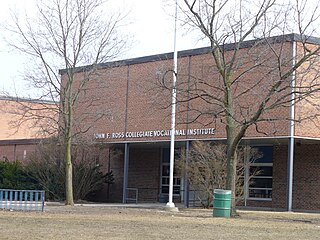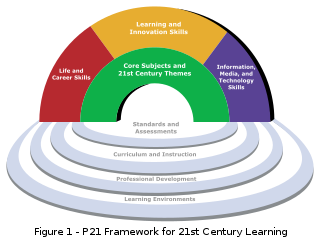Related Research Articles
Human capital or human assets is a concept used by economists to designate personal attributes considered useful in the production process. It encompasses employee knowledge, skills, know-how, good health, and education. Human capital has a substantial impact on individual earnings. Research indicates that human capital investments have high economic returns throughout childhood and young adulthood.

Vocational education is education that prepares people for a skilled craft as an artisan, trade as a tradesperson, or work as a technician. Vocational education can also be seen as that type of education given to an individual to prepare that individual to be gainfully employed or self employed with requisite skill. Vocational education is known by a variety of names, depending on the country concerned, including career and technical education, or acronyms such as TVET and TAFE.

Training is teaching, or developing in oneself or others, any skills and knowledge or fitness that relate to specific useful competencies. Training has specific goals of improving one's capability, capacity, productivity and performance. It forms the core of apprenticeships and provides the backbone of content at institutes of technology. In addition to the basic training required for a trade, occupation or profession, training may continue beyond initial competence to maintain, upgrade and update skills throughout working life. People within some professions and occupations may refer to this sort of training as professional development. Training also refers to the development of physical fitness related to a specific competence, such as sport, martial arts, military applications and some other occupations.

A career is an individual's metaphorical "journey" through learning, work and other aspects of life. There are a number of ways to define career and the term is used in a variety of ways.

Adult education, distinct from child education, is a practice in which adults engage in systematic and sustained self-educating activities in order to gain new forms of knowledge, skills, attitudes, or values. It can mean any form of learning adults engage in beyond traditional schooling, encompassing basic literacy to personal fulfillment as a lifelong learner, and to ensure the fulfillment of an individual.
A skill is the learned ability to act with determined results with good execution often within a given amount of time, energy, or both. Skills can often be divided into domain-general and domain-specific skills. For example, in the domain of work, some general skills would include time management, teamwork and leadership, self-motivation and others, whereas domain-specific skills would be used only for a certain job. Skill usually requires certain environmental stimuli and situations to assess the level of skill being shown and used.

Early childhood education (ECE), also known as nursery education, is a branch of education theory that relates to the teaching of children from birth up to the age of eight. Traditionally, this is up to the equivalent of third grade. ECE is described as an important period in child development.
Cooperative education is a structured method of combining classroom-based education with practical work experience.
Retraining or refresher training is the process of learning a new or the same old skill or trade for the same group of personnel. Retraining is required to be provided on a regular basis to avoid personnel obsolescence due to technological changes and the individuals' memory capacity. This short-term instruction course shall serve to re-acquaint personnel with skills previously learnt or to bring their knowledge or skills up-to-date (latest) so that skills stay sharp. This kind of training could be provided annually or more frequently as maybe required, based on the importance of consistency of the task of which the skill is involved. Examples of refreshers are cGMP, GDP, HSE trainings. Retraining shall also be conducted for an employee, when the employee is rated as ‘not qualified’ for a skill or knowledge, as determined based on the assessment of answers in the training questionnaire of the employee.
Employability refers to the attributes of a person that make that person able to gain and maintain employment.

Outdoor education is organized learning that takes place in the outdoors, typically during school camping trips. Outdoor education programs sometimes involve residential or journey wilderness-based experiences in which students participate in a variety of adventurous challenges and outdoor activities such as hiking, climbing, canoeing, ropes courses and group games. Outdoor education draws upon the philosophy, theory, and practices of experiential education and environmental education.

Chemistry education is the study of teaching and learning chemistry. It is one subset of STEM education or discipline-based education research (DBER). Topics in chemistry education include understanding how students learn chemistry and determining the most efficient methods to teach chemistry. There is a constant need to improve chemistry curricula and learning outcomes based on findings of chemistry education research (CER). Chemistry education can be improved by changing teaching methods and providing appropriate training to chemistry instructors, within many modes, including classroom lectures, demonstrations, and laboratory activities.
Workplace wellness, also known as corporate wellbeing outside the United States, is a broad term used to describe activities, programs, and/or organizational policies designed to support healthy behavior in the workplace. This often involves health education, medical screenings, weight management programs, and onsite fitness programs or facilities. It can also include flex-time for exercise, providing onsite kitchen and eating areas, offering healthy food options in vending machines, holding "walk and talk" meetings, and offering financial and other incentives for participation.
On-the-job training is an important topic of human resource management. It helps develop the career of the individual and the prosperous growth of the organization. On-the-job training is a form of training provided at the workplace. During the training, employees are familiarized with the working environment they will become part of. Employees also get a hands-on experience using machinery, equipment, tools, materials, etc. Part of on-the-job training is to face the challenges that occur during the performance of the job. An experienced employee or a manager are executing the role of the mentor who through written, or verbal instructions and demonstrations are passing on his/her knowledge and company-specific skills to the new employee. Executing the training on at the job location, rather than the classroom, creates a stress-free environment for the employees. On-the-job training is the most popular method of training not only in the United States but in most of the developed countries, such as the United Kingdom, Canada, Australia, etc. Its effectiveness is based on the use of existing workplace tools, machines, documents and equipment, and the knowledge of specialists who are working in this field. On-the-job training is easy to arrange and manage and it simplifies the process of adapting to the new workplace. On-the-job training is highly used for practical tasks. It is inexpensive, and it doesn't require special equipment that is normally used for a specific job. Upon satisfaction of completion of the training, the employer is expected to retain participants as regular employees.
Life skills are abilities for adaptive and positive behavior that enable humans to deal effectively with the demands and challenges of life. This concept is also termed as psychosocial competency. The subject varies greatly depending on social norms and community expectations but skills that function for well-being and aid individuals to develop into active and productive members of their communities are considered as life skills.
People skills are patterns of behavior and behavioral interactions. Among people, it is an umbrella term for skills under three related set of abilities: personal effectiveness, interaction skills, and intercession skills. This is an area of exploration about how a person behaves and how they are perceived irrespective of their thinking and feeling. It is further elaborated as dynamics between personal ecology and its function with other people's personality styles in numerous environments. British dictionary definition is "the ability to communicate effectively with people in a friendly way, especially in business" or personal effectiveness skills. In business it is a connection among people in a humane level to achieve productivity.
Educational neuroscience is an emerging scientific field that brings together researchers in cognitive neuroscience, developmental cognitive neuroscience, educational psychology, educational technology, education theory and other related disciplines to explore the interactions between biological processes and education. Researchers in educational neuroscience investigate the neural mechanisms of reading, numerical cognition, attention and their attendant difficulties including dyslexia, dyscalculia and ADHD as they relate to education. Researchers in this area may link basic findings in cognitive neuroscience with educational technology to help in curriculum implementation for mathematics education and reading education. The aim of educational neuroscience is to generate basic and applied research that will provide a new transdisciplinary account of learning and teaching, which is capable of informing education. A major goal of educational neuroscience is to bridge the gap between the two fields through a direct dialogue between researchers and educators, avoiding the "middlemen of the brain-based learning industry". These middlemen have a vested commercial interest in the selling of "neuromyths" and their supposed remedies.

Youth unemployment is a special case of unemployment; youth, here, meaning those between the ages of 15 and 24.

21st century skills comprise skills, abilities, and learning dispositions identified as requirements for success in 21st century society and workplaces by educators, business leaders, academics, and governmental agencies. This is part of an international movement focusing on the skills required for students to prepare for workplace success in a rapidly changing, digital society. Many of these skills are associated with deeper learning, which is based on mastering skills such as analytic reasoning, complex problem solving, and teamwork, which differ from traditional academic skills as these are not content knowledge-based.
TVE refers to all forms and levels of education and which provide knowledge and skills related to occupations in various sectors of economic and social life through formal, non-formal and informal learning methods in both school-based and work-based learning contexts.To achieve its aims and purposes, TVE focuses on the learning and mastery of specialized techniques and the scientific principles underlying those techniques, as well as general knowledge, skills and values.
References
- ↑ "Why "power skills" is the new term for soft skills in the hybrid work world". 18 February 2022.
- 1 2 "NACE Defines Career Readiness, Identifies Key Competencies". National Association of Colleges and Employers . Retrieved 9 March 2021.
The National Association of Colleges and Employers, through a task force of college career services and HR/staffing professionals, has developed a definition, based on extensive research among employers, and identified eight competencies associated with career readiness.
- ↑ Tritelli, David (20 January 2015). "Employers Judge Recent Graduates Ill-Prepared for Today's Workplace, Endorse Broad and Project-Based Learning as Best Preparation for Career Opportunity and Long-Term Success". Association of American Colleges and Universities . Retrieved 9 March 2021.
- ↑ "Core competencies — importance of a set of base transferable skills". National Skills Commission. Australian government. Retrieved 4 July 2021.
- ↑ Workforce connections: Key soft skills that foster youth workforce success, Child Trends, June 2015
- 1 2 3 Claxton, Guy; Costa, A.; Kallick, Bena. "Hard thinking about soft skills". Educational Leadership. 73: 60–64.
- ↑ "The Core Leadership Skills You Need in Every Role". Center for Creative Leadership. 24 November 2020. Retrieved 30 May 2021.
- ↑ CON Reg 350-100-1 (PDF), Fort Monroe, Virginia: UNITED STATES CONTINENTAL ARMY COMMAND, 1968, retrieved November 21, 2016
- ↑ Silber, K.H. & Foshay, W.R., Handbook of Improving Performance in the Workplace, Instructional Design and Training Delivery, John Wiley & Sons 2009, ISBN 9780470190685, p.63
- ↑ CON Reg 350-100-1, as cited in Whitmore, Paul G., "What are soft skills?"
- ↑ Katherine S. Newman, Chutes and Ladders: Navigating the Low-wage Labor Market, Harvard University Press 2006, ISBN 0674023366, p.351
- 1 2 3 Whitmore, Paul G., "What are soft skills?", Paper presented at the CONARC Soft Skills Conference, Texas, 12–13 December 1972
- ↑ Fry, John P., "Procedures for Implementing Soft-Skill Training in CONARC Schools," Paper presented at the CONARC Soft Skills Conference, Texas, 12–13 December 1972
- 1 2 Whitmore, Paul G.; Fry, John P., "Soft Skills: Definition, Behavioral Model Analysis, Training Procedures. Professional Paper 3-74.", Research Report ERIC Number: ED158043, 48pp.
- 1 2 3 4 5 Succi, Chiara. "Soft Skills for the Next Generation: Toward a Comparison between Employers and Graduate Students' Perceptions". Sociologia del Lavoro. 137: 244–256.
- ↑ Heckman and Kautz, Hard Evidence on Soft Skills, 2012
- ↑ "Employers Say Students Aren't Learning Soft Skills in College". Society for Human Resource Management. October 21, 2019. Retrieved December 4, 2020.
- 1 2 3 Levasseur, Robert E. (2013). "People Skills: Developing Soft Skills — a Change Management Perspective". Interfaces. 43 (6): 566–571. doi:10.1287/inte.2013.0703.
- ↑ Brown, Molly. "IT careers: 5 soft skills for engineering teams in 2022". The Enterprisers Project. Retrieved 23 February 2022.
- ↑ https://www.ryerson.ca/content/dam/diversity/reports/KSG2015_SoftSkills_FullReport.pdf [ bare URL PDF ]
- ↑ "Essential Skills Tracker 2023". Skills Builder. Retrieved 11 August 2023.
- 1 2 Skills for Social Progress: The Power of Social and Emotional Skills. OECD Skills Studies. 2015. doi:10.1787/9789264226159-en. ISBN 9789264226142 . Retrieved 2020-04-28.
{{cite book}}:|website=ignored (help) - ↑ "The returns of going to university are higher among those in the higher social and emotional skill deciles". Skills for Social Progress. OECD Skills Studies. 2015-03-10. doi:10.1787/9789264226159-graph16-en. ISBN 9789264226142. ISSN 2307-8731.
- ↑ King, Gary; Murray, Christopher J. L.; Salomon, Joshua A.; Tandon, Ajay (2003). "Enhancing the Validity and Cross-Cultural Comparability of Measurement in Survey Research" (PDF). The American Political Science Review. 97 (4): 567–583. doi:10.1017/S0003055403000881. ISSN 0003-0554. JSTOR 3593024. S2CID 229170977.
- ↑ Rutkowski, Leslie Davier, Matthias von Rutkowski, David (2013). Handbook of International large-scale assessment : background, technical issues, and methods of data analysis. CRC Press. ISBN 978-1-4398-9512-2. OCLC 867469251.
{{cite book}}: CS1 maint: multiple names: authors list (link) - ↑ "The Universal Framework". Skills Builder. Retrieved 11 August 2023.
- ↑ "Employers Say Students Aren't Learning Soft Skills in College". Society for Human Resource Management. October 21, 2019. Retrieved December 4, 2020.
- ↑ Crowley, Elizabeth (25 October 2019). "Tackling the future 'human' skills deficit together". Chartered Institute of Personnel and Development . Retrieved 1 February 2021.
- 1 2 3 Zhang, Aimao (2012). "Peer assessment of soft skills and hard skills". Journal of Information Technology Education: Research. 11: 155–168. doi: 10.28945/1634 .
- 1 2 3 Laker, Dennis R.; Powell, Jimmy L (2011). "The Differences between Hard and Soft Skills and Their Relative Impact on Training Transfer". Human Resource Development Quarterly. 22: 111–122. doi:10.1002/hrdq.20063.
- ↑ "OECD Skills Outlook 2019 : Thriving in a Digital World | en | OECD". www.oecd.org. Retrieved 2020-04-28.
- ↑ DeKorver, Brittland K.; Choi, Mark; Towns, Marcy (2017-02-14). "Exploration of a Method To Assess Children's Understandings of a Phenomenon after Viewing a Demonstration Show". Journal of Chemical Education. 94 (2): 149–156. Bibcode:2017JChEd..94..149D. doi:10.1021/acs.jchemed.6b00506. ISSN 0021-9584.
- ↑ Lee, C.-I.; Tsai, F.-Y. (2004-02-03). "Internet project-based learning environment: the effects of thinking styles on learning transfer". Journal of Computer Assisted Learning. 20 (1): 31–39. doi: 10.1111/j.1365-2729.2004.00063.x . ISSN 0266-4909.
- 1 2 Heckman, James J.; Kautz, Tim (2012-08-01). "Hard evidence on soft skills". Labour Economics. European Association of Labour Economists 23rd annual conference, Paphos, Cyprus, 22-24th September 2011. 19 (4): 451–464. doi:10.1016/j.labeco.2012.05.014. ISSN 0927-5371. PMC 3612993 . PMID 23559694.
- ↑ Krueger, Alan B.; Whitmore, Diane M. (2001-01-01). "The Effect of Attending a Small Class in the Early Grades on College-test Taking and Middle School Test Results: Evidence from Project Star" (PDF). The Economic Journal. 111 (468): 1–28. doi:10.1111/1468-0297.00586. ISSN 0013-0133.
- ↑ Bierman, Karen L.; Coie, John D.; Dodge, Kenneth A.; Greenberg, Mark T.; Lochman, John E.; McMahon, Robert J.; Pinderhughes, Ellen (April 2010). "The effects of a multiyear universal social–emotional learning program: The role of student and school characteristics". Journal of Consulting and Clinical Psychology. 78 (2): 156–168. doi:10.1037/a0018607. ISSN 1939-2117. PMC 3534742 . PMID 20350027.
- ↑ Dee, Thomas S.; West, Martin R. (March 2011). "The Non-Cognitive Returns to Class Size" (PDF). Educational Evaluation and Policy Analysis. 33 (1): 23–46. doi:10.3102/0162373710392370. ISSN 0162-3737. S2CID 36383874.
- ↑ Durlak, Joseph A.; Weissberg, Roger P.; Dymnicki, Allison B.; Taylor, Rebecca D.; Schellinger, Kriston B. (January 2011). "The Impact of Enhancing Students' Social and Emotional Learning: A Meta-Analysis of School-Based Universal Interventions". Child Development. 82 (1): 405–432. doi:10.1111/j.1467-8624.2010.01564.x. ISSN 0009-3920. PMID 21291449. S2CID 5689540.
- ↑ "IBM targets teaching soft skills in its most popular SkillsBuild courses". Fortune. Retrieved 2023-09-01.
- ↑ Yeo, Jennifer (2019-01-02). "Facing the challenges of the future of education". Learning: Research and Practice. 5 (1): 1–3. doi: 10.1080/23735082.2019.1585120 . ISSN 2373-5082.
- ↑ "OECD Skills Outlook 2019 : Thriving in a Digital World | en | OECD". www.oecd.org. Retrieved 2020-04-28.
- ↑ "OECD Future of Education and Skills 2030 - Organisation for Economic Co-operation and Development". www.oecd.org. Retrieved 2020-04-28.
- ↑ Cameron, Deborah (2000). Good to Talk?: Living and working in a communication culture. London, UK: Sage.
- ↑ Allan, Kori (2016). "Going Beyond Language: Soft skill-ing cultural difference and immigrant integration in Toronto, Canada". Multilingua. 35 (6): 617–647. doi:10.1515/multi-2015-0080. S2CID 152173634.
- ↑ Woronov, Terry (2008). "Raising Quality, Fostering "Creativity": Ideologies and Practices of Education Reform in Beijing". Anthropology & Education Quarterly. 39 (4): 401–422. doi:10.1111/j.1548-1492.2008.00030.x.
- ↑ Howlett, Zachary (2021). Meritocracy and its Discontents. Ithaca, NY: Cornell University Press.
- ↑ Hizi, Gil (2021). "Against Three "Cultural" Characters Speaks Self-Improvement: Social Critique and Desires for "Modernity" in Pedagogies of Soft Skills in Contemporary China". Anthropology and Education Quarterly. 52 (3): 237–253. doi:10.1111/aeq.12366. S2CID 234152158.
◦ Brieuc du Roscoät, Romaric Servajean-Hilst, Sébastien Bauvet and Rémi Lallement(2022), Soft skills related to innovation and organizational transformation. How to act in uncertainty?, Institut pour la transformation et l’innovation, March 2022 https://www.strategie.gouv.fr/english-articles/soft-skills-innovate-and-transform-organizations